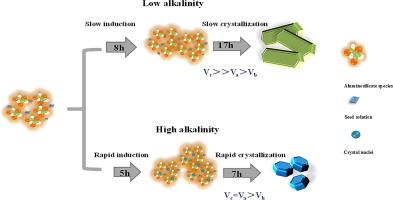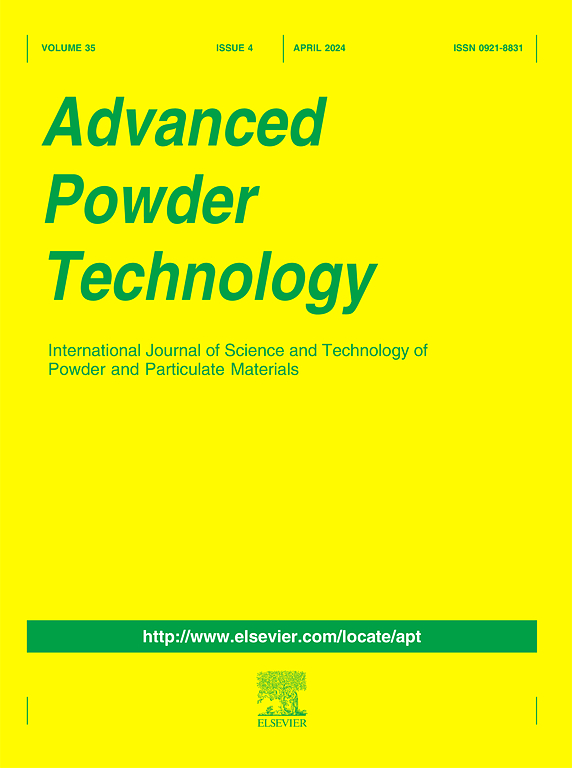Fluoride- and OSDA-free synthesis of ZSM-5 with controllable b-axis orientation: Insights into the role of medium alkalinity and seed induction
IF 4.2
2区 工程技术
Q2 ENGINEERING, CHEMICAL
引用次数: 0
Abstract
MFI-topology nanosheets with a b-axis-oriented structure are valuable catalysts in diffusion-controlled acid-catalyzed reactions. Therefore, b-axis-oriented ZSM-5 nanosheets were synthesized herein in a fluoride-free solution without using special additives and complex methods. The initial gel pH of mixed raw materials was adjusted to approximately 5–7 (weak acidity) to direct nanosheet structure formation. The target ZSM-5 zeolite with a b-axis-oriented structure was achieved through the synergistic effect between the involved gel pH and seed solution. The seed solution directed the formation of an MFI structure, and the low alkalinity of the gel limited crystal growth in the b plane, thereby affording b-axis-oriented thin sheets. The ratio of the lengths of the c and b axes of the obtained ZSM-5 could be effectively tuned by adjusting the pH of the initial gel. Compared with the nanosized hexagonal ZSM-5 sample synthesized in a strong-basic system, the as-synthesized b-axis-oriented ZSM-5 exhibited a lower coking rate and higher propylene yield during the considered 1-hexene cracking reaction.

具有可控 b 轴取向的 ZSM-5 的无氟和无 OSDA 合成:对培养基碱度和种子诱导作用的见解
具有 b 轴定向结构的 MFI 拓扑纳米片是扩散控制酸催化反应中的重要催化剂。因此,本文在无氟溶液中合成了以 b 轴为方向的 ZSM-5 纳米片,无需使用特殊添加剂和复杂方法。为了引导纳米片结构的形成,混合原料的初始凝胶 pH 值被调至约 5-7(弱酸性)。通过所涉及的凝胶 pH 值和种子溶液之间的协同效应,实现了具有 b 轴方向结构的 ZSM-5 目标沸石。种子溶液引导 MFI 结构的形成,而凝胶的低碱度限制了晶体在 b 平面的生长,从而获得了面向 b 轴的薄片。通过调节初始凝胶的 pH 值,可以有效地调整所得到的 ZSM-5 的 c 轴和 b 轴的长度比。与在强碱体系中合成的纳米六方 ZSM-5 样品相比,合成的 b 轴定向 ZSM-5 在所考虑的 1- 己烯裂解反应中表现出更低的结焦率和更高的丙烯产率。
本文章由计算机程序翻译,如有差异,请以英文原文为准。
求助全文
约1分钟内获得全文
求助全文
来源期刊

Advanced Powder Technology
工程技术-工程:化工
CiteScore
9.50
自引率
7.70%
发文量
424
审稿时长
55 days
期刊介绍:
The aim of Advanced Powder Technology is to meet the demand for an international journal that integrates all aspects of science and technology research on powder and particulate materials. The journal fulfills this purpose by publishing original research papers, rapid communications, reviews, and translated articles by prominent researchers worldwide.
The editorial work of Advanced Powder Technology, which was founded as the International Journal of the Society of Powder Technology, Japan, is now shared by distinguished board members, who operate in a unique framework designed to respond to the increasing global demand for articles on not only powder and particles, but also on various materials produced from them.
Advanced Powder Technology covers various areas, but a discussion of powder and particles is required in articles. Topics include: Production of powder and particulate materials in gases and liquids(nanoparticles, fine ceramics, pharmaceuticals, novel functional materials, etc.); Aerosol and colloidal processing; Powder and particle characterization; Dynamics and phenomena; Calculation and simulation (CFD, DEM, Monte Carlo method, population balance, etc.); Measurement and control of powder processes; Particle modification; Comminution; Powder handling and operations (storage, transport, granulation, separation, fluidization, etc.)
 求助内容:
求助内容: 应助结果提醒方式:
应助结果提醒方式:


